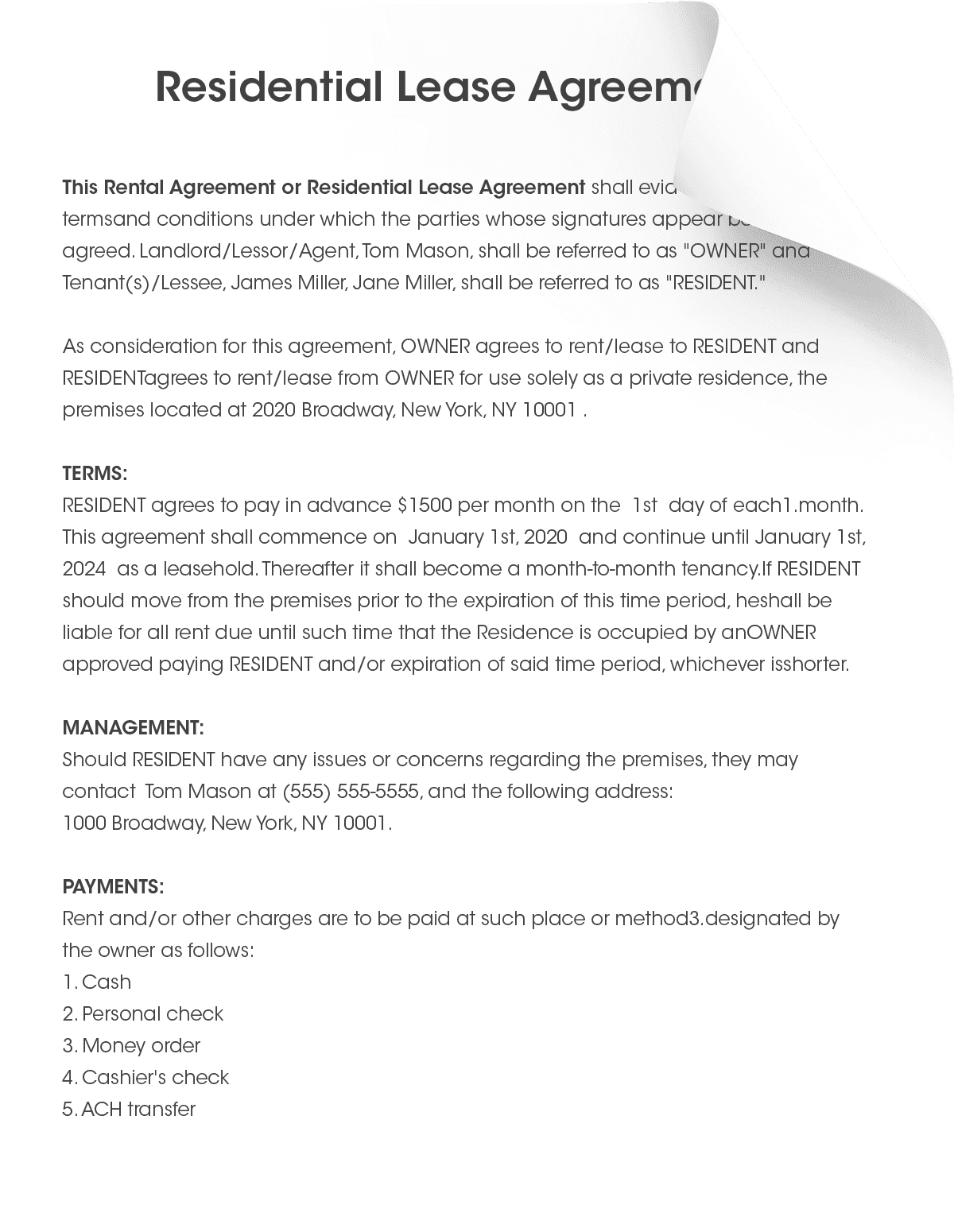What Is a Residential Lease Agreement?
Also known as a rental agreement or a residential rental contract, a residential lease agreement is a written agreement between a tenant and their landlord.
A lease lays out the terms under which a tenant can occupy a rental unit owned by the landlord.
These legally binding contracts also establish the terms of the lease, including:
- The date when the tenant will assume occupancy.
- How much rent payments will be, and how they will be paid.
- The lease period.
- The tenant’s security deposit.
Why Do You Need to Use a Rental Agreement?
A fixed-term lease agreement is a legal document written and used by landlords to establish the obligations and terms of their leased property.
The lease agreement allows the tenant to occupy the rental property for a defined period as long as the tenant complies with the terms of the contract and makes the agreed-upon rent payments.
Is There a Due Date for a Residential Lease Agreement?
A residential lease is needed if a landlord intends to lease a residential property to a tenant.
The rental lease agreement will detail the obligations of both the landlord and tenant, which provides legal protection for both parties.
Are There Any Deadlines or Times When a Residential Lease Agreement Is Needed?
A residential lease agreement needs to be in place before a tenant moves into the rental property.
The lease agreement will set the date the tenant will move in and establish the lease term. It would be difficult to implement a lease agreement in the middle of a tenant’s occupancy as conflict may arise.
Typically, once a lease agreement expires, it does not renew unless the landlord and tenant agree to this in the lease. This can be done month-to-month, but the terms would still be in place. A provision detailing the possibility of month-to-month at the end of the lease agreement should be in the lease.
What Information Should Be Included in a Standard Lease Agreement?
A standard residential lease should always be as detailed as possible. Rental agreements should flesh out specific issues or obligations that may arise during the period of the lease.
Standard lease agreements must have a written description of the property to be leased. It should also include the property’s address and other relevant details related to the premises, like if there will be a property manager looking after the unit. The property’s address is considered a valid legal description in a residential lease. Leases should also include the term, spelling out the start and end dates of the rental agreement.
A lease should also specify the amount of monthly rent due and how it shall be paid. For example, the lease should state whether the rent is to be paid by money order, cashier’s check, or electronically.
The due date needs to be specified as well as any grace period the landlord may extend for late payments. The lease should also include a late fee penalty or bounced check policy. The lease needs to identify the security deposit and a pet deposit.
A few standard terms used in leases include:
- Utility responsibilities.
- The keeping of pets.
- Parking.
- General maintenance, like lawn care.
- Pest control obligations.
- Property insurance.
- That the security deposit should be kept in an interest-bearing account.
The landlord may also include how many guests are permitted to stay on the premises and mention if the tenant has the authority to sublease the leased property, in which case a sublease agreement would need to be written.
Additionally, the landlord needs to spell out their access to the rental property, notice requirements, and methods of notice.
Can a Lease Be Cancelled?
Usually, a lease will include a section that relates to terminating the agreement. If either the landlord or the tenant wants to cancel the lease, they would need to follow the terms of the agreement to do so.
In some cases, a landlord may waive any penalties and allow the tenant to break the lease, but this will also depend on your local real estate laws.
What Are the The Most Common Landlord and Tenant Mistakes to Avoid?
A landlord is obligated by law to keep any rental properties habitable. A lease cannot contain a provision that waives the landlord’s duty to keep the property livable. If there is no provision for this in the lease, it may be deemed invalid.
Another provision that will invalidate a lease is requiring a tenant to waive their right to their security deposit. Landlords cannot have the tenant waive their rights to sue the landlord.
It is a good idea to identify who will be residing at the premises throughout the lease.
A landlord cannot increase a rent payment amount or alter the terms of the lease without permission from all parties. Any agreed-upon changes should be memorialized, and it is required that all parties sign the amended lease.
Do I Need to Use a Lawyer, Accountant, or Notary to Help Me?
You can easily create your own lease agreement without hiring a lawyer, accountant, or notary. Creating lease agreement forms online can save you time and money. It can also cut out hefty attorney fees.
Can I Write My Own Lease Agreement?
It is not advisable that you write your own lease agreement or try to adapt existing leases. As a lease is a legal document, you do not want to make errors that could end up costing you money in legal fees.
There are some standard terms that all leases include, but there are further details that may need to be added based on your specific circumstances.
For this reason, it is better to use an intelligent lease generator.
Why Use Our Free Lease Agreement Generator?
Downloading free lease agreement templates from the internet can be dangerous. You need a reliable way to create a legitimate and legally binding document that protects the landlord-tenant relationship.
Our easy-to-use tool helps you effortlessly create a residential lease agreement in less than five minutes.
Our tool also has a subscription plan to create unlimited residential lease agreements at affordable rates.





